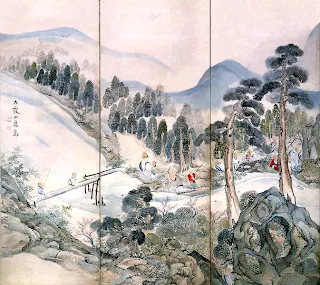In an old Chinese legend, an artist named Zhang Sengyou (張僧繇) was asked to paint a mural in a temple. He painted four dragons but left out the pupils from their eyes. The Abbot asked him why. Zhang explained that if he painted the pupils, the dragons would come alive. When the Abbot insisted, Zhang proceeded to paint two of the dragons’ eyes. As soon as he finished painting the pupils on two of the dragons, they roared to life and flew away in a thunderous flash of lightning. The two dragons that had no pupils stayed on the wall.
This story embodies the philosophy of East Asian ink wash painting. The goal is not simply to reproduce the appearance of the subject, but to capture its soul. To paint a horse, the ink wash painting artist must understand its temperament better than its muscles and bones. To paint a flower, there is no need to perfectly match its petals and colors, but it is essential to convey its liveliness and fragrance. East Asian ink wash painting may be regarded as an earliest form of expressionistic art that captures the unseen.
East Asian ink wash painting has long inspired modern artists in the West. In his classic book Composition, American artist and educator Arthur Wesley Dow (1857–1922) wrote this about ink wash painting: "The painter ...put upon the paper the fewest possible lines and tones; just enough to cause form, texture and effect to be felt. Every brush-touch must be full-charged with meaning, and useless detail eliminated. Put together all the good points in such a method, and you have the qualities of the highest art". Dow's fascination with ink wash painting not only shaped his own approach to art but also helped free many American modernists of the era, including his student Georgia O'Keeffe, from what he called a 'story-telling' approach. Dow strived for harmonic compositions through three elements: line, shading, and color. He advocated practicing with East Asian brushes and ink to develop aesthetic acuity with line and shading.
Shading in ink wash painting refers to the varying ink density produced by grinding an ink stick in water. Ink wash painting artists spend years practicing basic brush strokes to refine their brush movement and ink flow. In the hand of a master, a single stroke can produce astonishing variations in tonality, from deep black to silvery gray. Thus, in its original context, shading means more than just dark-light arrangement, it is the basis for the beautiful nuance in tonality unique to East Asian ink wash painting and brush-and-ink calligraphy. (Wikipedia)
The following slides of Asian ink wash paintings are created for art educators who wish to design a Power Point presentation for an art project that I will include with my collection of lesson plans in the near future. Read the Terms of Use before downloading the jpgs. and click on the thumbnails to download the very largest photo available.
 |
| Hasegawa Tohaku, 1539 - 1610 |
 |
Shiokawa Bunrin, Japanese, 1808-1877
River Landscape with Fireflies , 1874
Both screens are at The Nelson Atkins Museum, Kansas City Missouri |
 |
| Japanese screen at Tokyo National Museum |
 |
Dong Qichang. The Qingbian Mountains
|



















